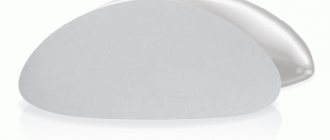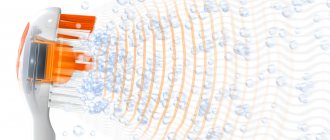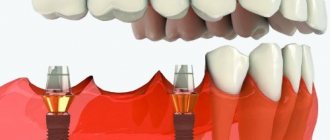In dental implantation, a very important point is the initial planning and selection of an orthopedic design, including crowns for implants. It is for this reason that in our SDent clinic, the initial examination and consultation is carried out not by an implantologist, but by an orthopedic dentist.
In order to correctly distribute the subsequent load on the teeth, the orthopedist clearly determines which dental implants to place, as well as the location and number of implants. Only after this does the implantologist give his opinion on the choice of types of implants, implantation techniques and the possibility of performing an operation without prior preparation for bone augmentation.
Unfortunately, it happens that some implantologists offer to install implants “without problems and quickly”, without taking into account all the subtleties of this process in combination with prosthetics.
A tooth on an implant consists of three parts: the artificial root itself - the implant, an abutment, which is inserted into the implant and serves as a supporting stump for the crown on top.
Crowns for implants differ in the material from which they are made and in the type of fixation to the implant.
Metal-ceramic crown.
They are a metal frame covered with ceramic mass on top. Can be installed on any teeth. There are some aesthetic disadvantages in the area of the anterior teeth. If the gums are naturally thin, the metal edge of the crown will be visible through the gums. If the enamel of your own teeth, located together with the tooth on the implant, is highly translucent, then the metal-ceramic crown will stand out against this background. On chewing teeth, such crowns perform their function perfectly.
A titanium abutment is installed under the metal-ceramic crown. There is no need for zirconium. Some dentists may offer a cobalt-chromium alloy abutment. It is up to the patient to decide whether or not to agree to this abutment option, but they are extremely unreliable and there is a risk of such an abutment breaking. It cannot be replaced, so it is removed along with the implant.
What is an abutment?
An abutment is an adapter head that is screwed to the implant, and on top of which, in turn, a crown (or any other prosthetic structure) is placed. Each implant system has its own set of various standard abutments.
The greater the choice of different configurations and sizes of abutments, the easier it is for the orthopedic surgeon to solve any clinical situation. Expensive popular systems have a wide range of these important spare parts, as they say, for all occasions. And so they are preferable. Therefore, the doctor often makes the choice of an implant system based on what possibilities for prosthetics are provided by a particular manufacturer. Equally important is the degree of accuracy and reliability of the connection between the abutment and the implant.
It's like a construction set, the parts of which must fit perfectly together. The service life of the entire structure largely depends on this. And here, as a rule, the simpler and more budget-friendly the system, the more flaws and design inconsistencies it encounters.
Which crown to choose?
In terms of cost, a metal-ceramic crown, as well as a titanium abutment for it, will cost less. They are more suitable for the chewing group of teeth, as they can withstand a greater chewing load and are less likely to cause ceramic chipping.
For the front teeth, the guideline will be determined by the physiology of your own teeth: how thin or thin the gums are, how transparent the enamel on the teeth is. When choosing metal-ceramics for the front teeth, the aesthetic appearance may not be very beautiful. Ideally, zirconium crowns are optimal for the frontal group, respectively, on a ceramic abutment.
Installation process
After the implant has taken root (this usually takes several months), you can proceed to installing a crown made from an individual impression. During this procedure, the dentist places the prosthesis on the abutment and connects it to the implant.
Fixation of the crown can be cement or screw. In the first case, the elements are connected to each other using a special adhesive composition. All manipulations take place in the patient’s oral cavity.
With screw fastening things are a little more complicated. First, the doctor makes a small hole in the crown. A screw is inserted through it, passing through the crown, and the abutment is screwed in. All of this occurs outside the client's mouth. When all the parts are firmly connected, the previously made hole is sealed without a trace.
With both installation methods, the patient does not feel any pain, since the gums have completely healed. Therefore, anesthesia is not required at this stage of implantation treatment.
Fixation of crowns supported by implants.
- Cement type of fixation.
The abutment is fixed into the implant using a specially selected screw. The doctor attaches the crown to the fixed abutment with special cement, which has shock-absorbing properties.
When cement fixation of a crown on an implant is used.
- There must be sufficient bite height: part of the abutment for fixation is 5 mm.
- Attached gum (fixed, fused with the periosteum) – height from 3 mm.
- The bone walls surrounding the neck of the implant are 2 mm thick.
- The antagonist teeth are in an ideally correct relationship.
The disadvantage of this fixation method is the inability to remove the crown and, if necessary, correct some aspects.
2. Screw type of fixation (transocclusal fixation).
The specialist connects the abutment and crown together, and then installs this structure into the implant. Fastens with a special screw. A hole remains on the body of the crown, which is completely invisibly closed with a special composite. Such crowns are performed by highly qualified dental technicians.
When is it better to use screw fastening of a crown on an implant?
- If at the same time as the implantation there was bone grafting (bone augmentation).
- There is a deficiency in the thickness of the attached gum.
- Fixing the temporary crown.
- Low clinical height of the coronal part.
- A bridge supported by 4 or more implants.
The advantages of screw fixation of the crown on the implant are that it is possible to remove the crown along with the abutment if correction is necessary.
Screw fixation has disadvantages:
— there is a possibility that the screw that connects the crown and abutment to the implant will loosen, causing mobility to appear. If you waste time and do not consult a specialist, you can get an inflammatory process in the form of peri-implantitis;
- when mobility appears, there is another danger - an abutment fracture (if you do not consult a doctor in time). It is almost impossible to remove such a fragment from the implant; it is removed along with the implant.
You can discuss the type of fixation of the crown on the implant at the German SDent center with our orthopedic specialists. They will expertly give recommendations on which type of fastening will be best in your clinical case.
How are prostheses made and installed?
Modern technologies are closely intertwined with dentistry and have given it the following opportunities:
- instead of conventional impressions, digital scanning of the oral cavity is carried out using intraoral 3D scanners, and the data is immediately sent to a computer - to a specialized program for creating a model of the prosthesis,
- modeling a perfect smile even at the stage of preparation for implantation (for example, using the Digital Smile Design concept),
- milling of prosthetic bases on high-precision machines: allows you to create a perfectly adjacent structure - both to the abutment and to the opposite teeth when the jaws are closed.
If we consider the installation in a simplified version, then after fixing the abutments, impressions are taken, then a model is created in the laboratory - and a prosthesis is already made on its basis. Then it is tried on, and if the doctor and the patient are satisfied with everything, then the structure is permanently attached (with screws or cement).
Timing of prosthetics with crowns on implants.
The timing of installing a permanent crown on an implant initially depends on the implantation technique.
- If there was an implantation with immediate loading, then the time for installing a permanent crown on the implant is significantly reduced. On the day of the implantation operation, a temporary crown was already installed. After complete osseointegration of the implant (from 2 to 6 months), you can immediately begin making a permanent crown for the implant. This takes from 2 to 4 weeks.
- If the implantation technique involved delayed prosthetics, then the implant was either completely sutured under the gum or a former was installed on it. After the implant has healed, a gum former is installed (if it was not installed at the time of implantation) for about 3 weeks, then the stage of a temporary crown on the implant is 3-4 weeks, after which 2-4 weeks to make a permanent crown on the implant. That is, the installation period for a permanent structure increases by approximately 1.5 months.
VERY IMPORTANT! Under no circumstances should you make a bridge that rests on your own tooth on one side and the crown on the implant on the other. Natural teeth are always somewhat mobile in the bone; the implant is fixed motionless. This design leads to problems both with the tooth and with the implant - it becomes loose and will soon need to be removed. A design that relies on your teeth and implants at the same time is unacceptable.
For more information and to make an appointment with a specialist, call:
+7,
or use the feedback form Sign up for a consultation and we will call you.
In order to make the right choice of a crown for an implant, come for a consultation at the German Es-Dent Center for Aesthetic Dentistry. Our specialists have extensive practical experience in the manufacture of various types of prostheses, do not stand still in professional development and use the latest dental technologies. We are always ready to answer all your questions about dental treatment and restoration in as much detail as possible.
Price is the second thing, the main thing is quality and guarantees!
Cost of installing a crown
per implant is calculated individually for each clinical case. The final price is announced after a full examination of the problem area.
You should always remember the first
simple rule
, which has proven itself in dentistry: do not be fooled by cheap prices, as they hide the low qualifications of the doctor and the desire of the clinic to save as much as possible on your health.
And you can’t save on your health, as the second simple rule
of life applies: “the miser pays twice.”
Crown for implant price.
| Name of service | price, rub. |
| Making a temporary crown supported by an implant | from 5900 |
| Metal-ceramic crown (KHS) supported by an implant | from 27700 |
| Ceramic crown on a zirconium oxide frame supported by an implant | from 45900 |
| Custom titanium abutment | from 17300 |
| Custom Zirconium Oxide Abutment | from 28080 |
Ilgam Vagifovich Mamedov
Dentist, orthopedist
28
years of experience
Doctor of the highest category
All types of orthopedic treatment
Sign up for a consultation
Content
- What kind of crowns are placed on implants?
- Metal-free crowns
- Metal-ceramic crowns
- Prosthetics on implants
- What to choose between a crown and an implant
Dental restoration using implantation is a modern, highly effective approach in modern dentistry. The titanium rod is implanted into hard tissue and becomes a complete replacement for the natural root. Such a pin will perform its functions for life. Below is the article about which crowns are best to place on implants.
Features of cement fixation
Before cementing, it is necessary to take an x-ray and carefully remove any remaining temporary dental adhesive. Cementing makes it possible to circumvent a number of limitations of the screw type of fastening:
- low occlusal stability;
- difficulty in manufacturing restorations with passive fitting.
There are also other features:
- soft tissues are mainly supported by the abutment;
- the crown is seated in such a way that its edge is at the same level or slightly apical to the gingival margin.
Purpose of temporary and permanent cements in dentistry
Temporary cements are used at intermediate stages of prosthetics. With their help, it is possible to prepare the gums for the installation of a prosthesis. The material can last from several days to 1-1.5 years. The indications are:
- The need to check the condition of the dental pulp in case of mild pain. For this purpose, a temporary crown is fixed and the tooth is observed for several days. If necessary, treatment is prescribed, then the prosthesis is attached with permanent glue.
- When treating deep caries, when you need to repeatedly put medicine into the dental canals. To minimize pain for the patient and avoid the risk of damage to the working area between procedures, a crown is installed using temporary cement.
- When it is necessary to temporarily place a structure during orthodontic treatment.
The temporary cement is not too strong, which makes it easier to remove the crown. Therefore, you should avoid eating too hard food and chewing on the side with the temporary structure installed. You can make a temporary cement composition by changing the ratio of the proportions of the usual one to the liquid.
Permanent is used at the final stage of prosthetics, it happens:
- Zinc phosphate - has a long working time, allows you to obtain a thin, uniform layer (thickness up to 10 microns).
- Synthetic, adhesive - mainly used when installing ceramic veneers and simple bridges.
- Glass ionomer - releases fluoride and has adhesion to the crown material.











